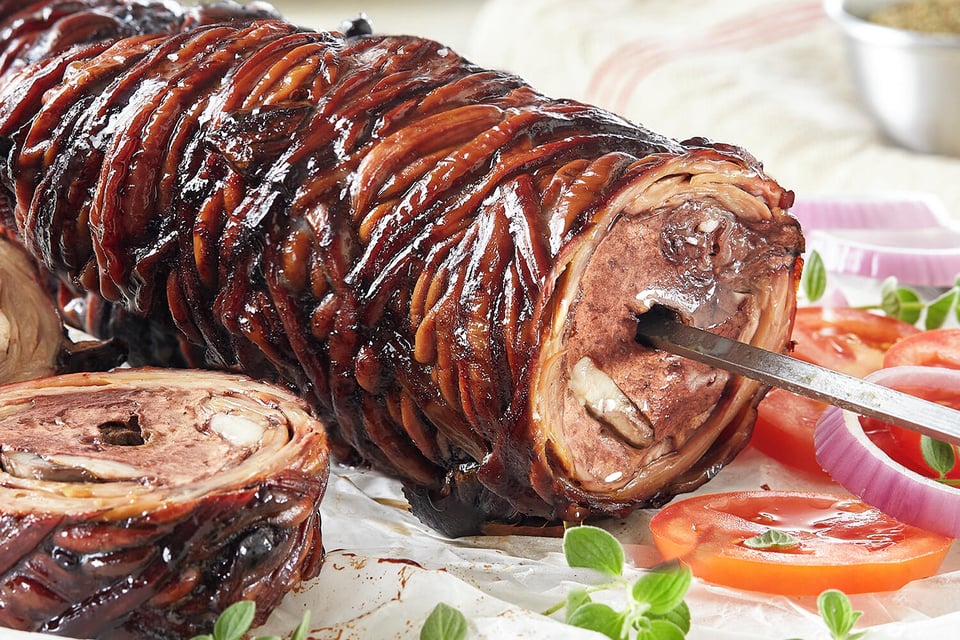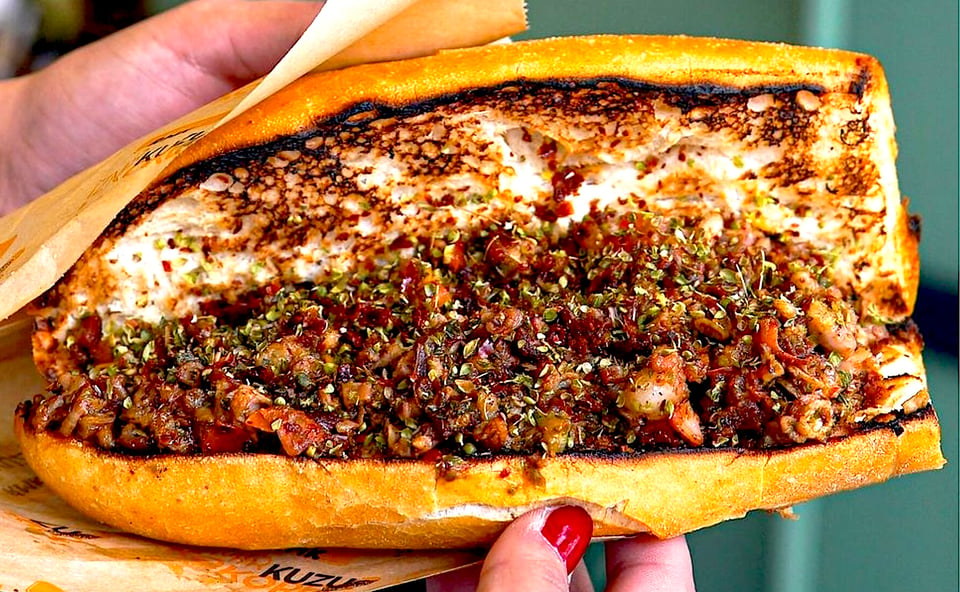Notable Sandwiches #102: Kokoretsi/Kokoreç

Welcome back to Notable Sandwiches, the series where I drag my long-suffering editor David Swanson through the bizarro, shifting sands of Wikipedia’s List of Notable Sandwiches, in alphabetical order. This week, a Greco-Turkish-Balkan delight: the kokoretsi, or kokoreç.

The first thing you’ll notice about the kokoretsi is that it’s strangely beautiful. This is not usually a distinguishing feature in offal-based meals; as delicious as I find them, dishes like chopped liver and sweetbreads are known more for their savor than their looks. But this Balkan and Anatolian sausage-like specialty, whose roots date back to the rosy-fingered days of Homer, is a thing of beauty—a mix of innards bound in a mesmerizing spiral of intestine. In Istanbul, where it’s called kokoreç, the spit-roasted treat is sold street-side as a sandwich—chopped up and served in a warm loaf, with a scattering of salt and spice to lighten the ferrous gaminess of the traditional preparation, with its potent mix of heart, kidney, and lung, wrapped in the intestine of suckling lamb. Strange as it seems, this whorled marvel is a feast for the eyes too, the product of a strange and ancient art.
And it really is ancient: the antecedent is directly attested to in the Iliad, as the appetizer for a full-on sheep roast, a way to kebab the quick-cooking offal while waiting as the sheep rests on the coals. Here’s an account in the Iliad:
“They cut out the thigh-bones, wrapped them round in two layers of fat, set some pieces of raw meat on the top of them, and then Chryses laid them on the wood fire and poured wine over them, while the young men stood near him with five-pronged spits in their hands. When the thigh-bones were burned and they had tasted the inward meats, they cut the rest up small, put the pieces upon the spits, roasted them till they were done, and drew them off: then, when they had finished their work and the feast was ready, they ate it, and every man had his full share, so that all were satisfied.”
(Every man, that is, except Achilles, who was apparently “gnawing at his own heart, pining for battle and the war cry.” No accounting for taste.)

As the classical scholar Susan Sheratt has pointed out, the propensity for roasting meat—and offal-quaffing—characteristic of Homer’s epic heroes has been preserved by the region’s populace in the ensuing centuries: “The standard method of cooking, whenever we hear anything about it, is the barbecue, which real heroes are clearly expected to accomplish for themselves rather than leave to underlings… the innards, which cook much more quickly than the flesh, are eaten, like the kokoretsi that precedes the meat at a modern Greek sheep roast.”
But things are never so simple in this corner of the world; the Turks, the Greeks, and various Balkan nations all lay claim to the dish. (For further elaboration on the Balkan food wars, please check out my favorite Key and Peele sketch of all time.) I make absolutely no claims as to which country in the former Byzantine or Ottoman Empire has dibs. Frankly, I’d like to keep my head on my neck.
The Sword and the Sandwich is a newsletter about deadly serious extremism and serious sandwiches. Please consider supporting this work with
a paid subscription.
Imperial recipes in Byzantium featured the dish, while the Turkish national epic poem, The Book of Dede Korkut, has plenty to say about sheep eating (in one moving testament to a man’s worth, he is told, “Give him ten thousand sheep/To make shish kebab for himself; he has virtue.”) But without weighing in on provenance, it should be noted that, as a sandwich, it’s much more common in Turkey. In the interests of a fuller aesthetic picture, we turned to a friend, former Village Voice colleague, and current New York Magazine film critic Bilge Ebiri, whose Turkish roots turned him on to the kokoreç in his childhood.
“I've eaten kokoreç for as long as I can remember,” says Ebiri, who calls it his favorite Turkish sandwich. “And here's the thing: I've generally eaten it on the street, from street vendors. And not always entirely reputable-seeming ones, which is a strange thing to think about when the dish in question is grilled intestine. But there's something particularly satisfying about watching a guy on the street slice it off a spit, chop it into little pieces, smother it in oregano, cumin, and red pepper, and then shove it into half a giant loaf of bread. There are never any condiments. Just the meat and the spices.”

Unfortunately, there aren’t really any purveyors of kokoreç—at least not the sandwich, slung with the incomparable insouciance and skill of the street vendor—in New York City, much to Ebiri’s and our sadness. (This is a tangent, but given our purview here, we did ask Bilge what the most notable sandwich in a movie is. The answer: “The one I always come back to is the crazy late night sandwich Kevin Kline makes in Dave, the movie in which he plays a body double who suddenly has to take over as President when the real guy is incapacitated. He's in the White House working on fixing the U.S. budget, and he makes a huge sandwich with everything in it, including sliced carrots. I think if I were President I would spend a lot of time making my own amazing sandwiches.”)
Back on track: it’s clear that the dish has a venerable past on the wine-dark shores of Anatolia and Greece alike; it may even be, according to one exhaustive and thoroughly enjoyable account by Australian food writer John Newton, part of the tradition that made us human. Eating “the soft bits”—the offal—may have granted our protohuman ancestors the spare calories and time off from chewing that allowed us to grow bigger brains than our ape-like forebears.

Accordingly, throughout human history, we’ve prized the soft parts; the liver of fallow deer used to be consecrated for England’s Medieval kings; foie gras has been served as a delicacy for monarchs and emperors from the Visigoths to the court of the Sun King. Nowadays, the world of offal-eaters mostly consists of bougie foodies and those who have always had to cook with whatever they have (and who incidentally usually make the best food). The vast, bland tapestry of the chicken breast, the enormous overhanging slab that is a steak, pale, for me, before the mineral vitality of what lies beneath.
Like liver wrapped in a lace of caul fat (which is also shockingly beautiful—it looks like delicate netting), kokoreç is a curious mix of the organic and the created, of history and of the present, a humble dish that once took part in sacrifices to the gods. Hear me, O god of the silver bow: give me fair winds and a sausage of soft innards, and I will go forth to battle with gladness in my heart.

-
honestly that key and peele sketch delivers what it said on the label. I feel stressed!
-
In Australia carrot, generally grated, (the thin slices made with a peeler as in Dave, are less common) is a very common ingredient that isn’t without detractors, In sandwiches and burgers. In the town of Broken Hill they mix the carrot with grated cheese and mayonnaise, call it ‘Cheese Slaw’ and put it with almost anything.
Add a comment: